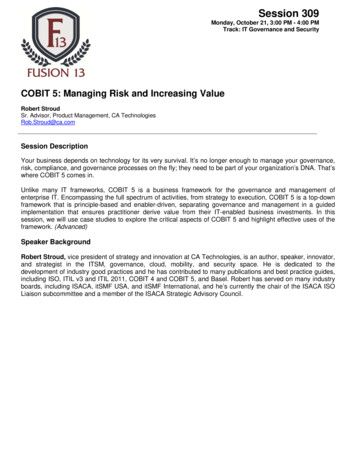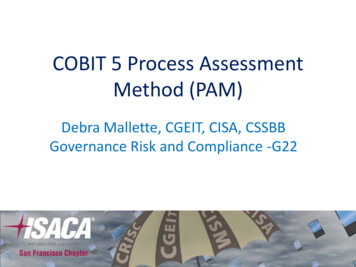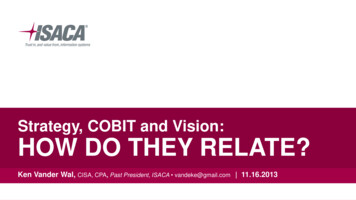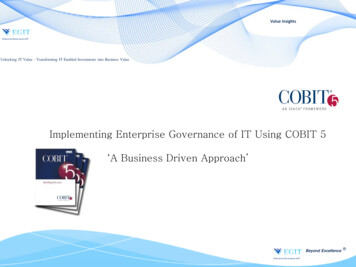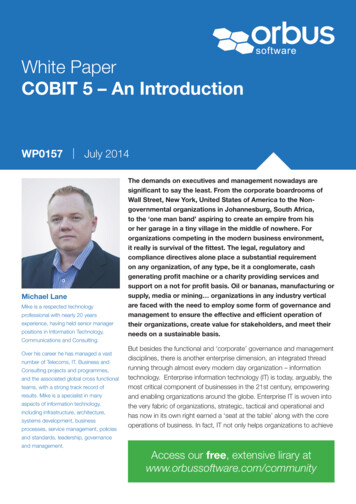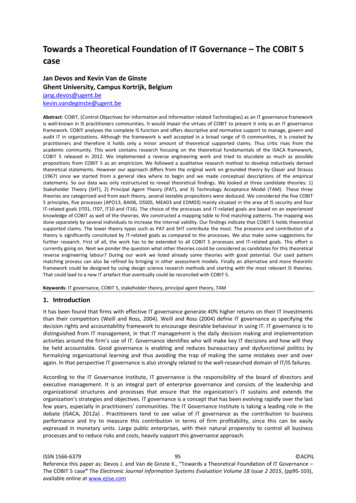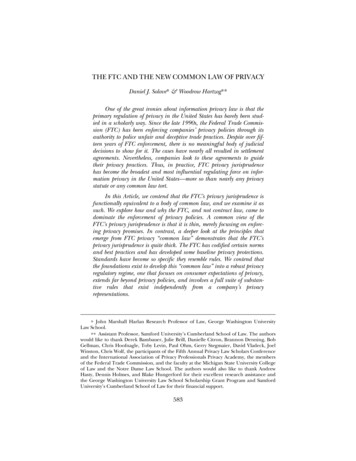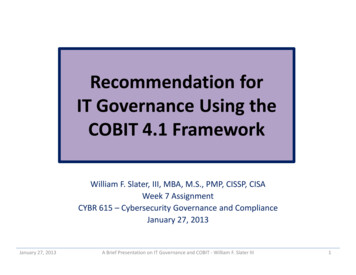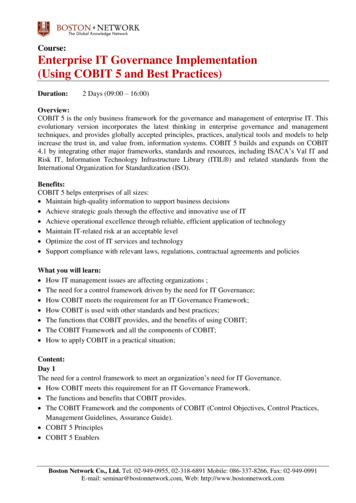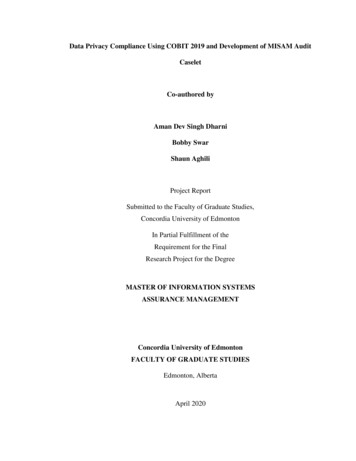
Transcription
Data Privacy Compliance Using COBIT 2019 and Development of MISAM AuditCaseletCo-authored byAman Dev Singh DharniBobby SwarShaun AghiliProject ReportSubmitted to the Faculty of Graduate Studies,Concordia University of EdmontonIn Partial Fulfillment of theRequirement for the FinalResearch Project for the DegreeMASTER OF INFORMATION SYSTEMSASSURANCE MANAGEMENTConcordia University of EdmontonFACULTY OF GRADUATE STUDIESEdmonton, AlbertaApril 2020
Data Privacy Compliance Using COBIT 2019 and Development of MISAM AuditCaseletAman Dev Singh DharniApproved:Bobby Swar (Approval on File)April 13, 2020Chair of MISSM/MISAM Research CommitteeEdgar Schmidt (Approval on File)Dean of Graduate StudiesDateApril 20, 2020Date
ABSTRACTIn recent times, ensuring data and user privacy has been one of the biggest impedimentsin information technology. With the advent of high penalties for privacy breaches and thehigh risk of reputation loss for a corporation, the need to comply with privacy regulationshave never been greater. This paper talks about the growing importance of data privacyand penalties imposed on organizations due to recent data breaches that compromised theconfidentiality of users. Additionally, privacy regulations PIPEDA and GDPR arediscussed along with leveraging COBIT 2019 framework to ensure PIPEDA and GDPRcompliance. Finally, an audit caselet is developed to help aspiring auditors design aPIPEDA and GDPR compliant audit checklist under the COBIT 2019 framework.Keywords: Data privacy, PIPEDA, GDPR, COBIT 2019, Compliance.
1. INTRODUCTION1.1 BackgroundIn order to gain competitive edge, create value to corporations and personaliseuser experience, data driven businesses have become highly dependent on the applicationof personal information. Today, organizations leverage consented personal informationand preferences of customers to improve business growth via targeted advertising andmarketing. Private user data has thus become an integral part of operations and businessdecision-making processes of enterprises worldwide. But, with greater adoption and evengreater development and integration of user data in business operations, comes the needfor governance structures, regulations and processes that can help ensure protection ofprivate user information from unconsented misuse. For instance, on 23 October 2020, theAustrian Data Protection Authority fined Austrian Post 18,000,000 for processing userdata without having the sufficient legal basis to do so. The Austrian data protectionauthority found out in its investigation that Austrian Post created profiles on Austriancitizens that included personal information like political party affiliations, house address,personal predilections, etc. and resold this confidential information to political parties andcompanies for targeted advertising. Hence, we can say that compliance to stricter lawsand regulations on gathering, exploiting, and distributing private data should not be takenlightly since non-compliance could lead to hefty fines.In addition to this, for aspiring auditors, a real time privacy audit of an enterpriseis not only nonviable, oftentimes, due to lack of experience, many auditors do not receive
a chance to get hands on experience on performing an audit early in their careers.Moreover, the recent release of COBIT 2019 means, not many security experts have yetimplemented the framework in their organizations. Therefore, designing a caselet foradopting COBIT 2019 framework in privacy compliance can greatly help aspiringauditors to improve their auditing skills and get an up to date knowledge of widelyaccepted and implemented security and privacy regulations like GDPR and PIPEDA.The rationale behind developing the caselet is to help would-be auditors to useCOBIT 2019 framework for steering privacy compliance for PIPEDA and GDPRregulations. Table 1 shows the list of recent white papers published by global consultingfirms and international professional associations that weigh upon the changingcompliance environment. And from Table 1 given below, we can infer that most auditfunctions are either planning or are already adopting innovative and up-to-date standardsand frameworks to tackle privacy risks.OrganizationInsightGartner, 2019In Gartner’s 2019 Audit Plan Hot Spots series, key risk areas thataudit departments anticipate focusing on 2019 have been identified.Here, data privacy is amongst the top 5 concerns as companies facemore advanced security breaches. The costs and risks ofinadequately managing and protecting data have exponentiallyincreased after the introduction of GDPR.
IIA, 2018Out of 636 Chief Audit Executives (CAEs), Directors, and SeniorManagers surveyed, for allocation of audit effort by risk area, 16%(second highest) of the anticipated allocation of resources wasexpected towards privacy compliance and regulatory requirements,which was not related to financial reporting.Deloitte, 2019In Deloitte’s internal audit insights for 2019, GDPR assurance andadvice has been considered in the top ten high-impact areas offocus. Deloitte states that “GDPR-related audits should now beconsidered in the annual risk assessment and internal audit planningprocesses”, just like SOX compliance. Internal Audit needs to helpthe corporation with measuring the risks, data requirements,processes and courses needed for privacy regulation fulfilment.ProtivitiProtiviti, a global consulting firm conducted a survey with 1113respondents consisting of CAEs, Digital leaders/Experts, and Auditstaff. In their research, they found that for 76% of the respondents,the internal audit department was currently undertaking or expectedto undertake transformation or innovation initiatives. But presently,only 25% were currently undertaking next-generation governancecompetencies. And 56% were planning to transform their auditprocess within the next one to two years.
KPMG, 2019In KPMG’s report of “Top 20 Key Risks to Consider by InternalAudit Before 2020”, GDPR compliance holds the 3rd position. Thereport emphasizes on GDPR being a major and highly influencingchange in information protection and user data privacy in recenthistory. And due to GDPR’s highly time dependent requirementslike the duty to inform regulation authorities about privateinformation breaches within 72 hours, organizations must have animble and continuous data protection and incidence responsecontrol in place.Table 1: Global Insight for Increasing Privacy ConcernsHarmonising between regulations periodically updated by the government tosupervise industrial advancements in information technology and the aim of defendingprivate information requires adoption of latest frameworks and being up to date with latestsecurity laws. Since a high amount of audit resource allocation is anticipated towardsprivacy fulfilment and regulatory requirements, it would be of great use to adopt recentlyupdated COBIT 2019 framework to ensure privacy compliance by creating a privacyaudit checklist. In addition to this, creating a caselet to use COBIT 2019 to ensure GDPRand PIPEDA compliance in an enterprise will greatly assist aspiring auditors in gainingprivacy audit experience.
1.2 Problem StatementData privacy (Gartner, 2018) and data governance (IIA, 2018) are one of the topfive key risk areas that Audit departments anticipate focusing on in 2019. Out of morethan 200 respondents surveyed in 2019 across Gartner’s global network of clientorganizations, 42% are not fully confident in Audit’s ability to provide assurance overdata privacy risks. For example, non-compliance to GDPR, a privacy regulation, canresult in a penalty of 4 percent of global annual turnover of the preceding financial yearor 20 million (GDPR, 2018). Thus, complying to privacy regulations is of paramountimportance to an enterprise. Additionally, aspiring auditors do not have the benefit ofimplementing COBIT 2019 for privacy audit in a live environment, and there are noCOBIT 2019 caselet available for privacy compliance implementation. Would-beauditors need to gain competency through case studies. Therefore, there is a need todevelop COBIT 2019 caselet focusing on privacy compliance.1.3 Summary Research StatementThis research contains an audit checklist for PIPEDA and GDPR complianceusing COBIT 2019 framework. Moreover, a comprehensive case study is designedenabling aspiring auditors to identify various GDPR and PIPEDA related privacyconsiderations in an enterprise. The case study will be used to create a privacy checklistfor an organization using COBIT 2019 framework and mapping the identified privacygaps corresponding to PIPEDA and GDPR requirements.
1.4 Organization of the Research PaperThe aim of this paper is to introduce the reader to the importance of user dataprivacy, give an outline on Personal Information Protection and Electronic DocumentsAct (PIPEDA), General Data Protection Regulation (GDPR) and deliver a brief overviewof COBIT 2019. The methodology section of this paper discusses the scope andlimitations of this research along with the research question that is raised. Finally, thispaper discusses the case study designed to help aspiring auditors perform a privacy auditand presents a user data privacy compliance checklist devised in accordance with theCOBIT 2019 framework.2. LITERATURE REVIEWThis section discusses the industry’s growing concerns with increasing cyberattacks resulting in the loss of data privacy and affecting consumers’ confidentiality,availability and integrity of information, along with handling information securityprograms for user awareness. Then later in this section, COBIT framework is discussedalong with privacy regulations Personal Information Protection and ElectronicDocuments Act (PIPEDA) and General Data Protection Regulation (GDPR).2.1 Data Privacy and Cyber-AttacksCyber-attacks are rising rapidly day by day, and they are no longer exclusivelytargeted towards big corporations. According to Zarka, Moin, and Karuna (2016), withthe growth and availability of new tools and practices, cyber-crime is increasing rapidly.The has led to an increased amount of cyber-attacks and the level of damage instigated to
the targeted individual. As per Navjeet (2015) and Andreea (2015), cyber criminals usevarious methods like brute force attacks, phishing, social engineering, man in the middleattacks, etc., to damage the integrity, availability and confidentiality of data, with as muchas 117,000 cyber-attacks being propagated every day. Successful execution of cyberattacks allows criminals to gain access to name, date of births, house address, medicalrecords, email address, insurance information, phone numbers, etc., of unsuspectingvictims. Zarka, Moin and Karuna (2016) also found that bank related cyber-crimes arerapidly growing. Although banks highly prioritize the security and safety of theircustomers, yet conservative and predictable security measures are no longer optimal toprevent hackers from bypassing them. As per Maria (2015) banks are four times morelikely to be targeted than regular businesses. The attacks include, but are not exclusive toonline payment fraud, internet transactions, ATM cards and machines, etc. Also, apartfrom cyber-attacks, customer privacy can be violated by sharing their private informationwith third parties, letting external organizations access user-data for personalised andtargeted advertising without user consent, giving insufficient information to customersregarding how their personal information will be processed, collecting more thannecessary user data, etc. Banks need a continuous risk assessment policy in place. Banksneed to keep a sharp eye on underlying system susceptibilities in banking networks andlatest tools and techniques used by hackers to side-step security protocols and initiateattacks. With an estimated fifty billion devices to be linked to the internet by 2019,regulation authorities need to come up with a robust plan to secure the personalinformation, rights and confidentiality of consumers. And, financial institutions need touninterruptedly employ safety nets to secure their customers’ data and confidentiality.
As per Navjeet (2015), security of transmitted data and stored data are one of thechief concerns while using the internet. In her paper, she states that the customer is themost delicate link in a bank’s security architecture, and even a small-scale attack, ifcarried out successfully, can bring down an entire corporation and cause massivereputation loss. Consequently, the majority of the attacks targeting net banking systemsare directed at the unsuspecting user by using social engineering methods to lure theminto giving their identification and authentication information which in turn compromisesthe user's net-banking services to perform unauthorised banking transactions. Stephan andEdward (2017) also identified users as the principal underlying limitation in anorganization’s information security infrastructure. User behaviour should be taken intoconsideration when creating the information security policy (ISP). Carrying outinformation security awareness programs and allowing all the employees to understandthe ISP policy is considered to be the most economical way of reducing data securityrisks. Stephen and Edward proposed a research model (Figure 1) which states that userawareness received via internal channels (awareness programs and trainings provided bythe organization like e-learning, internal newspapers, posters, etc.) and external channels(self-regulated research and learning, newspapers, T.V., YouTube, etc. and priorknowledge on the topic) both translating to improved information security awareness andenhanced positive outlook towards information security behaviours in the organization.In addition to this, the user’s attitude, and perceived social norms along with low level ofneutralization techniques (individuals convincing themselves and others that their nonstandard actions are justifiable, pardonable or forgivable) give rise to a greater intent ofbeing ISA program compliant. The proposed model was evaluated based on an employee
survey whose findings supported the case that carrying out information securityawareness programs raises user ISA and security compliance and positively influencesuser’s information security conduct.Figure 1: Information Security Awareness Retention Model (Stephan andEdward, 2017)Given below (Table 2) is a table of one of the most well-known data violations inrecent history, along with the resulting financial repercussions:OrganizationEquifaxData BreachFinancial RepercussionsIn 2017, Equifax lost the The company is now liable to payfinancialandprivate 575 million in a disbursement withinformation of nearly 150 the Federal Trade Commission.million users due to anunpatched framework in the
database. The company failed Equifax had already been finedto fix a critical vulnerability 500,000 in the United Kingdom themonths after a patch had been privacy breach.issued and then failed toinform the public regardingthe breach for weeks after itwas discovered.BritishIn 2018, British Airways used On 8th July 2019, British Airways wasAirwayscard skimming scripts to fined 204.6 million by the UK’s dataharvesttheprivate protection authority under the GDPRinformation and credit card regulation (Article 32).data of up to five hundredcustomers.UberIn 2016 Uber had six hundred Uber was penalised the largestthousand drivers and fifty- information-breach fine in history inseven million user accounts 2018 for 148 million for violatingcompromised. Uber also tried data breach notification regulations.to bribe the culprit 100,000to keep the hack away from
public’s notice and failed tonotifytheregulatingauthorities regarding the databreach.MarriottUK’sdataprotection Due to insufficient technical andInternationalauthority delivered a huge organisational measures to ensureInc.penalty over an information information security. On 9th Julyleak when payment info, and 2019, under GDPR law, Marriotpersonal user information of International Inc. was ordered to pay500 million clientele was 110,390,200 (Article 32)compromised.Google Inc.In January 2019, the CNIL Under Article 5, 6, 13, 14 of GDPR,committee enforced a fine Google was fined 50,000,000 on lizedInc.,for January 2019.inadequatetoitsconsentuseroveradvertisement
andforthetransparencylackoverofuserconsent policies.Table 2: Recent Data Breaches and Regulation Fines. Source: GDPR Enforcementtracker https://www.enforcementtracker.com/Therefore, data privacy is becoming one of the biggest consideration factors thatcan affect the financial and reputational stability of any enterprise.2.2 COBITCOBIT is an industry leading framework that has been developed by a non-profitorganization called ISACA. It pertains to information technology (IT) management andIT governance. It was built in 1996 to suit the requirements of both business executivesand IT professionals. Over the years, COBIT went through several iterations with thecurrent version being updated from COBIT 5 to COBIT 2019 (see Figure 2). To put itsimply, COBIT helps enterprises produce optimum usefulness from IT by maintaining afine balance between benefit realization, resource utilization and risk level optimization.COBIT assists information technology to be administered in an all-inclusive way for thewhole organization. This is done by taking into account the external and internalstakeholders’ IT-related interests and keeping in mind the entire functional andorganizational areas of accountability affected by information technology.
Figure 2: A Historical Timeline for COBIT (ISACA, 2019)2.2.1 COBIT 2019 – New FeaturesIn December 2018, ISACA released COBIT 2019. It became the successor toCOBIT 5 which was released in 2012. ISACA came up with four titles that were a part ofthe COBIT 2019 product family, namely:1. COBIT 2019 Framework: Introduction and Methodology - an outline to the main ideasof COBIT 2019.2. COBIT 2019 Framework: Governance and Management Objectives – This titlecomprehensively describes the forty fundamental governance and managementobjectives. They are then corresponded with the interrelated process, enterprise goals,and governance and management practices.
3. COBIT 2019 Design Guide: Designing an Information and Technology GovernanceSolution – This title investigates design factors that can affect governance and it comeswith a workflow planning tool that can be used to customize the organization’sgovernance system.4. COBIT 2019 Implementation Guide: Implementing and Optimizing an Informationand Technology Governance Solution - This title helps develop a road map foruninterrupted governance expansion and upgradation.The new features and terminologies that have been added or changed in COBIT2019 as compared to its predecessor can be detailed as follows:1. Enablers are now called components. And, there is a performance management processfor all 7 components.2. Managed Program and Managed Projects are 2 different objectives in BIA (Build,Acquire and Implement).3. BIA’s Managed Change process is now called Managed IT changes objective.4. The Governance System has 6 principles and the Governance Framework has 3principles.5. As compared to 17 Enterprise Goals and IT Goals each earlier, now there are only 13Enterprise Goals and 13 IT Goals.6. Capability assessment based on Capability Maturity Model Integration version 2.0.7. 11 design factors have been introduced and ISACA has created an Excel-based toolkitfor a greater understanding of the factors.
2.2.2 COBIT 2019 for PrivacyCOBIT 2019’s six underlying principles help us understand the fundamentalnotions behind the framework but how do these principles align with privacy risks?ISACA’s privacy principles work hand in hand with the COBIT framework, providingsafeguards for an organization and ultimately giving value to its stakeholders (ISACA,2017). It can be briefly explained as follows:1. Provide Stakeholder Value:1.1. Recognizing and understanding stakeholders’ need for privacy.1.2. Building customer, employee and stakeholders’ trust by safeguarding their privacy.1.3. Giving value to stakeholders by providing protection from and reducing the risk ofidentity fraud and other harms.2. Holistic Approach:2.1. Identifying privacy risks based on already defined processes, information datatypes, organizational structure, behaviors and cultures.2.2. Providing enterprises with privacy protection guidelines to be implementedalongside COBIT 2019 components, thus minimizing privacy risks to acceptablelevels when the business implements actions to meet enterprise goals.3. Dynamic Governance System:3.1. Applying an integrated framework aligning enterprise IT, information security andprivacy through COBIT 2019’s alignment with generally accepted privacystandards and governance models.4. Governance Distinct from Management:
4.1. Promoting responsible privacy behavior to protect the privacy of all individualsassociated with the business by fostering a privacy-positive culture to deliver anoptimistic privacy-protection influence on the behavior of all personnel.4.2. Ensuring privacy controls are integrated into business activities that involves anykind of personal information.5. Tailored to Enterprise Needs5.1. Adopting a risk-based approach to ensure that privacy risk is mitigated in aconsistent and effective manner and concentrating on critical business applicationsin which a privacy breach would have the greatest business impact.6. End-to End Governance System6.1. Identifying where personal data exists within the organizational environment andhow it flows throughout the enterprise.6.2. Defining and implementing privacy protection controls within all processes thatimpact privacy inside the enterprise.2.3 PIPEDAThe Personal Information Protection and Electronic Documents Act is a privacyregulation originating from Canada. PIPEDA became a regulation on 13 April 2000. Forprivate-sector organizations in Canada, PIPEDA is the federal privacy law. The purposeof the law is to “govern the collection, use and disclosure of personal information whilemaintaining the right to privacy of individuals with respect to their personal informationand the need of organizations to collect, use or disclose personal information for purposes
that would considered appropriate by a reasonable person under the circumstances”(PIPEDA, 2019).According to this act “all businesses that operate in Canada and handle personalinformation that crosses provincial or national borders are subject to PIPEDA, regardlessof the province or territory in which they are based”. Any information that can helpsuccessfully identify a person and acquired in the course a profitable activity is consideredas personal information under PIPEDA regulation. Listed below are the componentsconsidered as personal information.1. Name and age of the person.2. A person’s income3. A person’s ethnicity, nationality or race.4. Whether he/she is married/single.5. Employment history.6. Educational history.7. DNA and medical history.8. Social insurance number.9. Driver’s license number, among many other things.As of first November 2018, institutes under the PIPEDA regulation need toevaluate the loss of private data that can cause substantial harm to the subject, when theyexperience a data breach. In order to be PIPEDA compliant, businesses need to:
1. Report to the Privacy Commissioner of Canada breaches of security safeguardsinvolving personal information that pose a real risk of significant harm to individuals.2. Notify affected individuals about those breaches.3. Notify any other organization that may be able to mitigate harm to affected individuals.4. Track and keep records of all breaches for at least 24 months following the date itdetermined that a breach occurred.The federal Privacy Commissioner governs PIPEDA. The power to address thepublic regarding encroachments of the regulation and referring severe cases to FederalCourt lies with the Privacy Commissioner. The five phases of PIPEDA act enforcementare:1. Complaint – Written by an individual to the Privacy Commissioner or initiated by theCommissioner’s own accord.2. Investigation – The Commissioner carries out investigation and has the power to obtainoral or written evidence on oath, access organizational premises and conduct physicalchecks.3. Report – The report contains summary from both the complainant and the defendant,and then comes up to a common conclusion or agreement, within a year of complaintsubmission date.4. Compliance Agreement – The agreement contains terms necessary for compliancewith PIPEDA, and the federal court has the power to enforce the term of thecompliance agreement in case of non-obedience.
5. Hearing – The hearing is conducted at the federal court. Here, damages are awardedto the complainant if proven guilty and the court can order the business to issue a noticeof any measure(s) taken to rectify the business practice/process.2.4 GDPRAs per EU’s GDPR website, “the General Data Protection Regulation 2016/679(GDPR) is a regulation in EU law on data protection and privacy for all individual citizensof the European Union (EU) and the European Economic Area (EEA). It also addressesthe transfer of personal data outside the EU and EEA areas. In 2016, GDPR (effective on25 May 2018) was adopted to replace the Directive 95/46/EC to implement a legallybinding regulation that will be considered the EU data protection law. GDPR gives EUresidents control over their personal data wherever in the world the data may reside.”Figure 3: Key GDPR Domains (ISACA, 2018)
GDPR not only standardizes regulation across the EU and EEA, it also affects allenterprises that process data from EU/EEA countries. Figure 3 represents key domainsand associated requirements under GDPR. As per Information Commissioner’s Office(ICO), they are seven fundamental philosophies that GDPR sets out:1. Transparency, equality & lawfulness – Auditors must ensure that enterprises have thesystems and processes in place to ensure that consent rights and contract obligationsare not breached.2. Purpose limitation – When undertaking user consent to process data for a specificpurpose, the same data cannot be used again for another purpose.3. Data minimisation – “Enterprises must limit personal data collection, storage andusage to what is relevant and necessary for processing”. This means that companiesshould not collect and store private information just in case they might become usefulin future. Therefore, data collected should only pertain to accomplishing a specifictask.4. Accuracy – Personal information should reflect the most recent status of the entity.Additionally, enterprises should not replicate user data.5. Storage limitation – Personal information shall not be stored for longer than what isessential for administration. Data storage can be extended exclusively for archivingpurposes in “public interest, scientific or historical research purposes or statisticalpurposes”.6. Confidentiality, Integrity and Availability - Personal data must be processed usingfitting organizational and technical safety procedures and include protection againstillegal access to maintain the CIA triad.
7. Accountability - Under GDPR, a data controller is the lawful individual or agencywhich regulates the means and reasons for computing private user information.Therefore, the controller is accountable for ensuring compliance with the six keyprinciples mentioned earlier.Ideally, the seven fundamental principles should be obeyed when crafting a decentinformation protection policy. For GDPR non-compliance, an organization is liable to befined the higher of either 20 million European pounds, or 4% of the company’s entireglobal yearly turnover.3. METHODOLOGY3.1 Research ScopeUnder the research’s scope, we use COBIT 2019 framework to help perform aPIPEDA and GDPR compliant audit by creating a privacy audit checklist. A caselet isdeveloped, based on which a data privacy compliance checklist is designed. Ahypothetical organization (GreatTrust bank) is created where privacy risks are identifiedand then mapped in line with PIPEDA and GDPR compliance regulation requirementswhile being in line with the COBIT 2019 framework.
3.2 Research LimitationsThe limitation of the proposed research paper will be:1. Not being able to test the feasibility of the created audit checklist in a realorganization.2. The audit checklist will primarily focus on the data privacy compliance for PIPEDAand GDPR requirements only.3.3 Research QuestionHow can the COBIT 2019 framework be implemented to provide greater auditassurance pertaining to privacy of users?How can an aspiring auditor gain competency of conducting a data privacycompliance audit in line with the COBIT 2019 framework?3.4 Procedural MethodologyThe procedural methodology followed in the research is as follows:1. Reviewed and analyzed PIPEDA and GDPR regulatory documents. Created a list ofgoverning requirements that are necessary for an organization to be PIPEDA andGDPR compliant.2. Analyzed COBIT 2019 Framework. Identified how the regulatory requirements ofPIPEDA and GDPR could be mapped to COBIT’s Governance and ManagementObjectives.3. Determined the essential privacy policy objectives that hold true for all organizations.
4. Combined steps 1., 2. and 3. to create a user data privacy audit checklist in MS EXCELwhich is PIPEDA and GDPR compliant and aligned with COBIT 2019 framework.5. Utilized the literature review and analysis done so far to create a “Study Guide”. Thisguide contains a brief overview of COBIT framework, PIPEDA regulation and GDPRregulation.6. Created a case study for a hypothetical organization (GreatTrust Bank). The case studycontains deliverable instructions, learning objectives, company background,or
using COBIT 2019 framework. Moreover, a comprehensive case study is designed enabling aspiring auditors to identify various GDPR and PIPEDA related privacy considerations in an enterprise. The case study will be used to create a privacy checklist for an organization using COBIT 2019 framework and mapping the identified privacy
